
Health tips to keep you safe and well this summer
The temperature is rising and we’re finally enjoying the long, hot days of summer. While summer can be a nice break from the chilly days of seasons past, it can also bring unwanted health problems like dehydration, upset stomach, bacterial infections and heat stroke among others.
Whether you’re holidaying at home or abroad this year, it’s important to eat the right foods and exercise the right way to deal with these summer-related issues. Restore and replenish your skin and your wider physical health by following our healthy diet tips to surviving summer.
Keep yourself hydrated
Drinking enough water is crucial, as it helps to rehydrate your body, enabling it to function properly. With dehydration from heat stress being linked to a deterioration in mental function (1). Make sure to drink at least 9 cups per day for women and 11 cups per day for men (2). Your body may even require more, depending on your activity level that day and the temperature! Snacking on hydrating foods like watermelon and strawberries (3) is a delicious way to replenish your system.
Be sun safe
The majority of skin cancers are caused by too much exposure to ultraviolet (UV) rays from the sun (4) and manmade sources such as tanning booths (5). Always make sure to protect your skin from the sun when going outside, especially during the long, hot days of summer.
Before purchasing a sunscreen make sure to do your research. The Environmental Working Group (EWG) is a useful website where you can look up the safety of various sunscreen brands and their ingredients. They say that based on studies some chemical UV filters may mimic hormones. And o be aware of sunscreen-related skin allergies which raises concern about unintended human health consequences from frequent chemical sunscreen application.
The most concerning substance being oxybenzone which has been shown to cause allergic skin reactions (6). With other research showing it as a potential hormone disruptor with estrogen like properties(7).
Sunscreens based around zinc oxide are said to be one of the safes options. With a comprehensive 2018 study explaining that broad spectrum zinc oxide sunscreens can be safely applied in repeated doses without the risk of local skin toxicity(8). Babo Botanicals, Green People and Badger are great brands carrying a range of zinc oxide sunscreens.
- When outside, wear light, loose clothing and a hat to protect as much skin as possible. Wear sunglasses that block at least 99% of UV light to protect your eyes.
- Choose a zinc oxide based broad-spectrum sunscreen with a sun protection factor (SPF) of 30 or more. Reapply every two hours and straight after swimming.
- Try your best to avoid direct sunlight completely between, between 10 a.m. and 4 p.m., when UV rays are strongest.
- Tanning beds and sunlamps may cause serious long-term skin damage and contribute to skin cancer. Both should be avoided.
Get active
Physical activity is a crucial part of a healthy lifestyle in all seasons for overall health and anti-aging benefits(9). The warmer weather can make exercising outdoors a nice option for the whole family. But make sure to take the right precautions to avoid overheating in the hotter weather.
- Workout in the morning or evening, as it will be cooler outdoors. Stick to shaded areas if possible. If it’s too hot to go out, head to the gym or go up and down the stairs a few times.
- Wear light-coloured, loose-fitting clothing to help keep you cooler. If possible, wear a cap or a wide-brimmed hat.
- Plan an outdoor vacation. Camping, hiking, kayaking and snorkelling are excellent ways to immerse yourself in nature and increase your physical activity. If visiting a city, why not rent a bike or take a walking tour.
Eat right
Summer is the best time to enjoy an outdoor meal. Nourishing salads, hydrating melons and berries add health benefits, colour and flavour to picnics. Warmer temperatures, however, can spoil food, so you’ll need to be careful.
- Wash your hands, utensils, Tupperware and work surfaces before handling food to stop harmful bacteria from spreading.
- Cook your food on the same day as the picnic, not in advance. This gives bacteria less time to grow.
- Keep mayonnaise- or egg-based foods and other cold foods in a cooler with lots of frozen gel packs to avoid bacterial issues(10).
- Don’t keep leftovers that have been sitting out for more than two hours.
Include probiotics in your routine
Summer is as good a time as any to create a healthier routine, especially one that promotes good gut health. This is especially important if travel is on your agenda. Travel can be a fun but frantic time, so your normal, healthy diet may not be an option. You’ll likely be eating out more and trying new foods in new locations. It’s easy to overeat in this setting and you likely to want to try new things that might not go down too well with your gut. Whether you travel by plane, car or boat, the journey can often stress your body and digestive system(11).
Whatever your plans this summer, one of the best ways to support your gut is by taking a high-quality probiotic supplement, which will add more good bacteria to your gut(12). Probiotics are your little helpers, restoring order and helping maintain harmony in your gut’s complex ecosystem.
Not only do these beneficial bacteria help manage common digestive health issues (like diarrhoea(13) and constipation(14)), but they may also help build a stronger immune system thanks to the gut health and immunity connection. Go for a multi-strain probiotic with around 30 billion CFUs.
Beware of ‘healthy’ smoothies and juices
Fruit smoothies and fruit juices(15) might be a tempting way to stay refreshed throughout the summer… but watch out! The sugar content in these ‘health drinks’ can be staggering. If you’re determined to have one, try to make sure it also contains vegetables as well as protein sources. This will help to reduce the sugar content and will also slow the release of sugar into your bloodstream, keeping your blood sugar balanced(16).
You should also avoid smoothies made with frozen yoghurts or ice cream, which are loaded with hidden calories! Go for one made with milk or water instead.
Finally, we couldn’t offer a list of tips for a healthy and safe summer in 2020 without including some Coronavirus safety tips:
Covid-19 summer safety tips
- Pack your travel bag with plenty of face masks (they’ll be mandatory on some or all flights and other modes of transport, and probably in many other places home or abroad), bacterial wipes, hand sanitizer, gloves and snacks.
- If you eat or drink on the plane, remember to use a fresh mask and to wipe down your tray table before and after eating.
- The in-flight/onboard service will likely be cashless, so make sure you have debit or credit cards.
- Book dinners out or excursions in advance to avoid disappointment. In some cases, you may even need to book in for a swim time in the swimming pool!
- This is a summer where having your own car is preferable to using public transport or airport transfers. You may also wish to explore the neighbouring resorts or towns on your own, rather than in an organised excursion.
Due to the unique summer situation we are all facing, we must be ready to embrace change and remember that we are all in this together. Travelling during Covid-19 will be a completely different experience to what we are used to. This applies whether you are going on a staycation or a vacation.
Shopping, eating out, visiting bars and attractions will feel strange for some time, no matter where you are. To keep safe make sure you follow the local public health advice, wear your mask whenever possible and maintain social distancing.
Remember, travelling isn’t only about discovering new places; it’s about switching off and spending time with loved ones. This is the summer to slow down, take it easy and appreciated what we have. One thing’s for sure, it’s a summer we won’t easily forget.
References:
1. Gopinathan, P.M., Pichan, G. and Sharma, V.M. (1988). Role of Dehydration in Heat Stress-Induced Variations in Mental Performance. Archives of Environmental Health: An International Journal, [online] 43(1), pp.15–17. Available at: https://pubmed.ncbi.nlm.nih.gov/3355239/ (Accessed 26 Jul. 2020)
2. Read “Dietary Reference Intakes for Water, Potassium, Sodium, Chloride, and Sulfate” at NAP.edu. (n.d.). [online] nap.edu. Available at: https://www.nap.edu/read/10925/chapter/6 [Accessed 27 Jul. 2020]
3. Popkin, B.M., D’Anci, K.E. and Rosenberg, I.H. (2010). Water, hydration, and health. Nutrition Reviews, [online] 68(8), pp.439–458. Available at: https://pmc.ncbi.nlm.nih.gov/articles/PMC2908954/table/T1/ (Accessed 26 Jul. 2020)
4. D’Orazio, J., Jarrett, S., Amaro-Ortiz, A. and Scott, T. (2013). UV Radiation and the Skin. International Journal of Molecular Sciences, [online] 14(6), pp.12222–12248. Available at: https://pmc.ncbi.nlm.nih.gov/articles/PMC3709783/ [Accessed 27 Jul. 2020]
5. Fischer, A.H., Wang, T.S., Yenokyan, G., Kang, S. and Chien, A.L. (2017). Association of Indoor Tanning Frequency With Risky Sun Protection Practices and Skin Cancer Screening. JAMA dermatology, [online] 153(2), pp.168–174. Available at: https://pubmed.ncbi.nlm.nih.gov/27732686/ [Accessed 25 Jul. 2020]
6. DiNardo, J.C. and Downs, C.A. (2017). Dermatological and environmental toxicological impact of the sunscreen ingredient oxybenzone/benzophenone-3. Journal of Cosmetic Dermatology, [online] 17(1), pp.15–19. Available at: https://onlinelibrary.wiley.com/doi/abs/10.1111/jocd.12449 [Accessed 4 Aug. 2020]
7. Wang, J., Pan, L., Wu, S., Lu, L., Xu, Y., Zhu, Y., Guo, M. and Zhuang, S. (2016). Recent Advances on Endocrine Disrupting Effects of UV Filters. International Journal of Environmental Research and Public Health, [online] 13(8). Available at: https://pmc.ncbi.nlm.nih.gov/articles/PMC4997468/ [Accessed 4 Aug. 2020]
8. Mohammed, Y.H., Holmes, A., Haridass, I.N., Sanchez, W.Y., Studier, H., Grice, J.E., Benson, H.A.E. and Roberts, M.S. (2019). Support for the Safe Use of Zinc Oxide Nanoparticle Sunscreens: Lack of Skin Penetration or Cellular Toxicity after Repeated Application in Volunteers. Journal of Investigative Dermatology, [online] 139(2), pp.308–315. Available at: https://www.jidonline.org/article/S0022-202X(18)32655-1/fulltext [Accessed 4 Aug. 2020]
9. Garatachea, N., Pareja-Galeano, H., Sanchis-Gomar, F., Santos-Lozano, A., Fiuza-Luces, C., Morán, M., Emanuele, E., Joyner, M.J. and Lucia, A. (2015). Exercise Attenuates the Major Hallmarks of Aging. Rejuvenation Research, [online] 18(1), pp.57–89. Available at: https://pmc.ncbi.nlm.nih.gov/articles/PMC4340807/ [Accessed 26 Jul. 2020]
10. Keerthirathne, T.P., Ross, K., Fallowfield, H. and Whiley, H. (2019). The Combined Effect of pH and Temperature on the Survival of Salmonella enterica Serovar Typhimurium and Implications for the Preparation of Raw Egg Mayonnaise. Pathogens, [online] 8(4), p.218. Available at: https://pmc.ncbi.nlm.nih.gov/articles/PMC6963437/ [Accessed 26 Jul. 2020]
11. Information, N.C. for B., Pike, U.S.N.L. of M. 8600 R., MD, B. and Usa, 20894 (2019). Traveler’s diarrhea. [online] ncbi.nlm.nih.gov. Institute for Quality and Efficiency in Health Care (IQWiG). Available at: https://www.ncbi.nlm.nih.gov/books/NBK373093/ [Accessed 26 Jul. 2020]
12. Hemarajata, P. and Versalovic, J. (2012). Effects of probiotics on gut microbiota: mechanisms of intestinal immunomodulation and neuromodulation. Therapeutic Advances in Gastroenterology, [online] 6(1), pp.39–51. Available at: https://pmc.ncbi.nlm.nih.gov/articles/PMC3539293/ [Accessed 25 Jul. 2020]
13. Lye, H.S., Balakrishnan, K., Thiagarajah, K., Mohd Ismail, N.I. and Ooi, S.Y. (2016). Beneficial Properties of Probiotics. Tropical Life Sciences Research, [online] 27(2), pp.73–90. Available at: https://pmc.ncbi.nlm.nih.gov/articles/PMC5031164/ [Accessed 26 Jul. 2020]
14. Chmielewska, A. and Szajewska, H. (2010). Systematic review of randomised controlled trials: Probiotics for functional constipation. World Journal of Gastroenterology : WJG, [online] 16(1), pp.69–75. Available at: https://pmc.ncbi.nlm.nih.gov/articles/PMC2799919/ [Accessed 27 Jul. 2020].
15. Xi, B., Li, S., Liu, Z., Tian, H., Yin, X., Huai, P., Tang, W., Zhou, D. and Steffen, L.M. (2014). Intake of Fruit Juice and Incidence of Type 2 Diabetes: A Systematic Review and Meta-Analysis. PLoS ONE, [online] 9(3), p.e93471. Available at: https://pmc.ncbi.nlm.nih.gov/articles/PMC3969361/ [Accessed 27 Jul. 2020]
16. Gannon, M.C., Nuttall, F.Q., Saeed, A., Jordan, K. and Hoover, H. (2003). An increase in dietary protein improves the blood glucose response in persons with type 2 diabetes. The American Journal of Clinical Nutrition, [online] 78(4), pp.734–741. Available at: https://academic.oup.com/ajcn/article/78/4/734/4690022 [Accessed 25 Jul. 2020]


